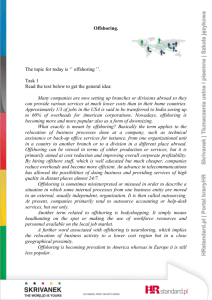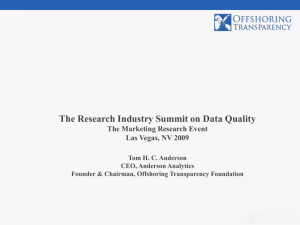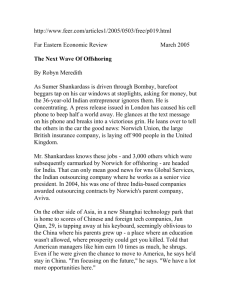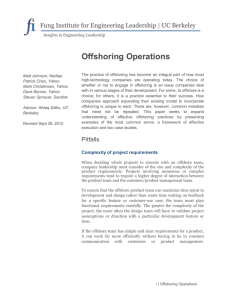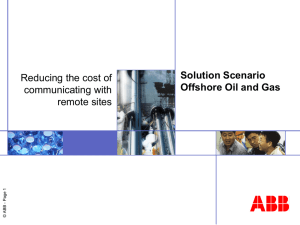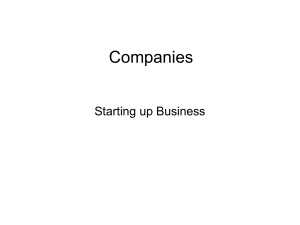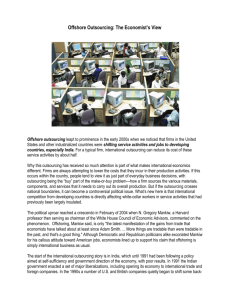Offshore Outsourcing
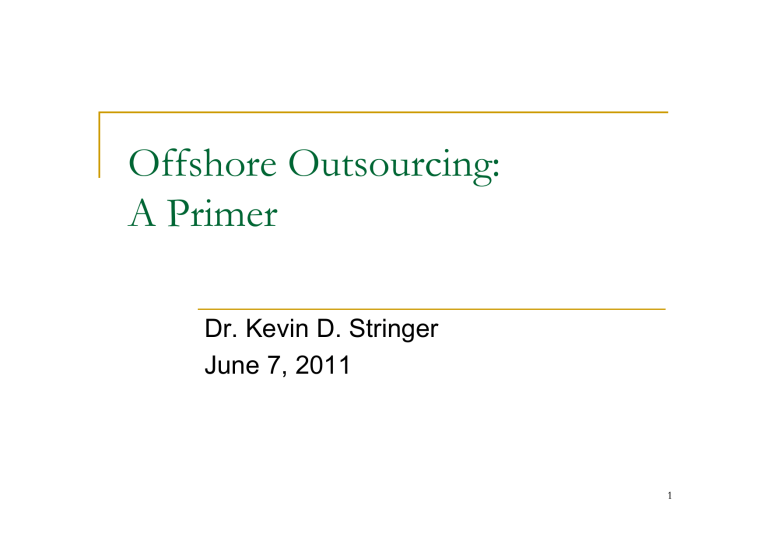
Offshore Outsourcing:
A Primer
Dr. Kevin D. Stringer
June 7, 2011
11
Agenda
What is offshore outsourcing?
Why offshoring?
Offshoring strategies and business approach
Sample locations – India, Poland, the
Philippines
Directed questions
2
SECTION 1
What is Offshore Outsourcing?
GEN0190n.ppt
3
What is offshore outsourcing?
♦
Outsourcing refers to the transfer of business processes from inside an organization to outside an organization. The people who conduct the business processes change from internal employees to professionals outside the organization.
♦
Offshore Outsourcing refers to the cross-border transfer of business processes to a provider located outside a firm’s home country of operations and typically in a location with greater available talent and lower cost.
Joint
Venture
♦
Other terms: Nearshoring, Bestshoring, Backshoring Captive
2%
♦
There are 4 general types of offshoring models: 12%
– External company (vendor)
– Internal team of employees (captive)
Hybrid
49%
– Hybrid (mixture of vendor and captive models)
– New legal entity between a vendor and captive (Joint venture)
Vendor
37%
Financial Institutions
Breakdown 2009
4
Sourcing (out, in, off, near)
Company
Operations
5
The original outsourcing gurus
6
7
Competitive Disadvantage
Production costs
Procure from Market In-house production
7
7
Another guru
Ronald Coase,
Nobel Prize in Economics, 1991
8
Outsourcing based upon competitive advantage and transaction costs
9
Examples of transaction costs (1)
Resources spent on guarding against opportunistic behaviour by vendors
Finding reliable vendors
Drafting contracts
Enforcing contracts
Dispute resolution
Monitoring mechanisms
10
Examples of transaction costs (2)
Resources spent on managing transitioning, and interactions with a (remote) vendor that would have occurred “naturally” in-house
Travel
(Tele) communications
Coordination mistakes
Knowledge acquisition and transfer
11
3 main types of offshoring
Business Process
Offshoring
(BPO)
♦
BPO is the offshoring of a specific business process task, which often involves executing standardized and transactional processes
♦
Sample BPO functions includes back-office work, billing, purchasing, payroll and administration, trade processing (OTC, FX, securities, etc)
♦
KPO is the offshoring of processes that demand research, analytical and decision-making / judgement skills.
♦
Sample KPO work includes MIS reporting, data mining, equity and fixed income business research, data analysis and financial modelling / analysis
IT Offshoring
(ITO)
♦
ITO is the offshoring of IT applications and infrastructure functions
♦
Sample ITO work includes application development, prototyping, testing and maintenance
BPO, KPO and ITO are the three most established types of offshoring in the industry
12
13
Activities being offshored (complexity)
• Content development
• Product design services
• Customer analytics
• Portfolio & risk management
• Equity research
• Wealth management research
• Fin. & Acctg., HR, Procurement shared services
• Technology support
• Operational transaction processing
• Inbound customer relations & helpdesk Outbound telemarketing
• Collections
Data Processing
• Basic data entry
• Transaction processing
13
13
Headlines on industry trends
KPO industry is expected to grow at 45% a year and to top $17 billion by
2010.
Onshore, Nearshore, Offshore:
Unsure, 2010
The global BPO industry, currently estimated at $26-29 billion, has grown at
35 per cent over the last few years and will be worth $450 billion by 2012.
The banking, capital insurance and manufacturing verticals will constitute 70 per cent of this global BPO market. Everest Group, 2008
In 2008, the ITO market was estimated to be worth $250 billion, with annual growth rates of 6-9%.
LSE Outsourcing Unit
Report, 2009
GEN0190n.ppt
14
What are the preferred locations?
Canada
Ireland
Eastern
Europe
Russia
China
Near shore
Toronto
Mexico
Location
India
Philippines
China
Near shore
Ireland
% of companies with offshore presence
100%
19%
16%
13%
9%
Share of offshore headcount
72%
3%
4%
2%
1%
Respondents allowed multiple choice
Source: Deloitte and Gartner
Mexico
City
India
Dublin
Moscow
Warsaw
Budapest
Shanghai
Delhi
Hyderabad
Mumbai
Bangalore
Chennai
Manila
Kuala
Lumpur
Singapore
Singapore
Malaysia
Sydney
Philippines
Australia
15
Ireland – a pioneer
16
SECTION 2
Why Outsource to Offshore locations?
17
Potential benefits of offshoring
A wide variety of benefits may make offshoring appropriate in several business situations
Access to a large pool of qualified employees at a lower cost
Reduce costs
Address open positions/ skill shortages to grow
Follow the sun operations
(up to 7 x 24 h)
Extend working hours
Offer additional service
Enhance quality and controls
Focus on client service
18
Why are banks offshoring?
Cost reduction is still a main driver to move offshore
Achieve Cost Savings
Improve Quality
Improve Time to Market
Gain Technical Skillsets
Forced Strategy
Cost Predictability
Penetrate Market
Gain Industry Experience
0 10 20 30 40 50
Source: Ventoro – Offshore 2007 and Gartner, 2008-09
GEN0190n.ppt
60 70 80
% of respondents
19
And the broader industry sample set?
For CFOs and CIOs, access to skill-sets seems to be more important
Business transformation
Focus on core business
Impact competitive advantage
Gain 3rd party expertise
Free internal resources
Access innovation
Cost reduction
Access Skill sets
0 10 20 30 40 50 60 70 80
% of respondents
Source: Cognizant and Warwick Business School Research, 2009
GEN0190n.ppt
20
SECTION 3
Offshoring strategy and business approach
21
What should an offshoring strategy do?
Create differentiation
Create greater business value
Reconfigure value chain or contribute to value shop development
Cost savings alone is not sustainable!
Imitating competitors is dangerous!
22
Which approach to offshoring?
Company culture and politics………..
Centralized
Top down targets
No exceptions
Holistic view to the company operating model
Company leverage towards vendors and scale and scope increases
Desire to change business model
Decentralized
Sub-units define targets
Lots of exceptions
No firm-wide view
Fragmented leverage
Vendor’s gain arbitrage opportunities
Cost savings is often main catalyst
..will have a big impact on the approach taken
23
Example: DB Global Transaction
Banking
NY
Dublin
LO FRA
Competence Centers
Frankfurt Bangalore
Processing Centers
24
SECTION 4
Sample locations – India, Poland, the Philippines
25
Gross cost comparisons: India - Europe
Business Process Offshoring (BPO)
Thousands
300
250
200
150
100
50
0
150
Onshore
22
15
Of f shore
Personnel
Ongoing infrastructure costs
Total onshore cost
Knowledge Process Offshoring (KPO)
Thousands
300
250
200
150
100
50
0
300
Onshore
24
38
Off shore
75% overall savings
E.g., back-office work, administration etc.
79% overall savings
E.g., research and other tasks requiring specialist knowledge
GEN0190n.ppt
26
Ex. Goldman Sachs in Bangalore
Goldman Sachs offshoring research to India
Bangalore
♦
Small Cap research team was created to assist in completing the initial research work required to cover companies. This significantly increased the amount of companies covered by the Equity
Research Dept.
♦
Offshore Quantum team (team of 12, compensation between ~8,500 USD and 27,000
USD p.a. per person) reduced number of onshore contracted Grant Thornton accountants saving approximately 4.5 million dollars on a 12 million dollar contract
♦
Portfolio Business Analyst (compensation was
~27,000 USD p.a.) took on a project usually outsourced to Grant Thornton accountants that cost 28,000 USD per quarter
GEN0190n.ppt
27
But consider the risks in India
Inequality within a rising population
Water shortages
High oil prices
Global protectionism
Climate change
Infectious diseases
Source: Victor Mallet, “The utopian myth of India’s double dividend,” FT, December 6, 2007
28
Social instability
India has a small part of the population with the GDP of
Mexico and the rest with a
GDP of sub-Saharan Africa
Home-grown Maoists
(Naxalites) have exploited resentment over official corruption and the widening gap between rich and poor to control large swaths of rural India.
Maoist insurgency in 172 of
India’s 600 districts
29
Social issues
As Palaniappan Chidambaram, erstwhile Indian trade minister noted in a conversation with Financial
Times,
“Do you know what the population of Finland is, “ he asked? “5 million. We have 5 million blind people in
India alone.”
Source: Gideon Rachman, “For nations, small is beautiful,” Financial Times, Dec 4, 2007, 13.
30
GINI Coefficient Report 2009
This is the most commonly used measure of inequality. The coefficient varies between 0, which reflects complete equality and 1, which indicates complete inequality
(one person has all the income or consumption, all others have none)
31
GINI Coefficient Report 2009
32
Resource scarcity
India imports 70% of its oil from the Middle East and has no strategic reserves
The Indian government subsidy on food, oil, and fertilizer is equivalent to the entire collection on income tax
India has 18% of the world’s population but only 4% of its freshwater and just over 2% of its land area
33
Numbers can be deceiving
With a population of 1.1 billion India has the highest absolute numbers of people receiving hardly any education
Literacy rate is a low 61%
About 2% of India’s existing workforce has skills training compared to 96% in Korea,
75% in Germany, and 68% in the USA
Source: Goldman Sachs Global Economics Paper, 169, June 16, 2008 and India’s Borderless Workforce, Manpower, 2008
34
Talent is not always at the same level
Only 13 percent of the university graduates from 28 low-wage nations are suitable for jobs in most multinational companies.
Regionally, the differences are more marked.
So while 50% of the engineers in Hungary or
Poland could work for multinational companies, only 10 % and 25 % of those in
China and India, respectively could do so.
Source: Diana Farrell, ed. Offshoring: Understanding the Emerging Global Labor Market, McKinsey Global Institute 2006.
35
Poland
36
Poland’s talent pool
POLAND
♦
Largest working population in Central Europe and one of the youngest populations on the continent
– 50% of the Polish society is under the age of 34
– 35% is below the age of 25
♦
Over 2 million students enrolled at universities
– Almost 400,000 graduates/year
♦
126 higher education academies, including 35 universities
♦
Foreign language skills: English, German, French,
Italian, Spanish, Russian
37
University graduates per year in Poland
25 000
21 000
30 000
44 000
41 000
14 000
76 000
33 000
27 000
20 000
34 000
GEN0190n.ppt
38
Poland cost comparisons
Typical onshore/offshore salary cost comparison 2010
Business Process Offshoring (BPO)
Thousands
300
250
200
150
100
50
0
150
33
Onshore Poland e.g. Back-office work, Administration etc.
Knowledge Process Offshoring (KPO)
Thousands
300
250
200
150
100
50
0
275
45
Onshore Poland e.g. Research and other tasks requiring specialist knowledge
Ca. 60% overall savings
Source: Grafton Recruitment, 2010.
Ca. 83% overall savings
GEN0190n.ppt
39
BPO
Gdansk
Olsztyn
Szczecin
Wroclaw
Warszawa
Poznan
Lodz
Czestochowa
Katowice
Bielsko
– Biala
Krakow
Lublin
GEN0190n.ppt
40
IT or Call Centers
Gdansk
Olsztyn
Szczecin
Wroclaw
Poznan
Bydgoszcz
Lodz
Warszawa
Katowice
Kielce
Krakow
GEN0190n.ppt
41
Fewer risks
European Union member
NATO member
Closely connected to US and Europe
Cultural fit
Nevertheless…….
42
Corruption Index 2010
Rank (09)
1 (1)
8 (5)
20 (17)
22 (19)
25 (24)
41 (49)
78 (79)
87 (84)
178 (178)
Country
New Zealand
Switzerland
United Kingdom
United States
France
Poland
China
India
Somalia
Source: Transparency International, Corruption Index 2010
7.1
6.8
5.3
3.5
3.3
1.1
Score
9.3
8.7
7.6
43
Case: State Street in Poland
Challenges:
Increased demand for fund services
Competition (BONY, Northern Trust)
Limited capacity in existing locations (Luxembourg,Ireland)
Solution:
Krakow captive – culture, quality, value proposition
Krakow costs when benchmarked across Europe at an 8% salary spiral take ca. 20 years to reach average
But, not as productive as other European locations. Needs
2 years or more.
India was not a choice…….Why?
44
Case: State Street in Poland (2)
Focused business - fund accounting
Top Management targets, support, and buyin
Goal to move the Poland operation up the value chain from simple to complex funds administration
When does it just become another European office?
45
The Philippines
46
Philippine IT-BPO: excellence in voice
/ growing non-voice capability
47
Growth Business
One of the fastest-growing industries in the country
Major contact centers in the Philippines: 218
Total full-time employees: 280,000
Estimated revenues in 2009: US$5 billion
Revenue growth from 2008: 30%
Key Players in the Country
Third-party providers: Convergys, TeleTech, Stream Global
Services, Sykes Asia, Aegis PeopleSupport, Teleperformance,
Sitel, CyberCity Teleservices, Telus, ePLDT Ventus, Sutherland,
ACS, HTMT, IBM Daksh, KGB, Transcomm, ePerformax,
Link2Support, Genpact
Captives: HSBC, Dell, Shell, AIG, Siemens, Verizon, Citigroup,
Six Continents–Intercon Hotels, Henkel Financial Services, GE
Money, Trend Micro, Oracle Technology, Western Union, Ford
(Percepta), DHL
2009 Offshoring
Destination of the Year
National
Outsourcing
Association, UK
48
The Philippine value proposition
Comparison of direct operating cost 1 per FTE for transactional F&A work
2008; US$ thousand per annum
75-85
~75% savings
65-75
~70% savings
40-45
34-39
19-21 18-20
1 Operating cost includes salary, facilities, equipment, telecom, training, and attrition cost
Source: Everest Research Institute (2008) and BPAP (Manila costs)
49
Qualitative challenges & solutions
There are a number of challenges which are typically faced when working with offshore teams
Challenges Solution
Work with different cultures
Maintaining high quality standards
♦
Cultural training
♦
Personal interaction through visits
♦
Onshore training for team leads
♦
Coaching
♦
"Shadow" key outputs in both locations in initial phase
♦
Regular structured feedback both ways
Efficiently utilizing capacity
♦
Involve offshore managers in departmental resource allocation meetings
♦
Clearly designed process for assigning work offshore
Managing different time zones (US)
♦
Ensure overlap
Retaining Staff
♦
Integration into onshore team
♦
Onshore travel
♦
Clearly defined career path
GEN0190n.ppt
50
SECTION 5
Directed Questions and Answers –
The Larger Offshoring Challenge
51
Concerns
Economic
Issues
Social
Political
GEN0190n.ppt
52
Directed large group questions
♦ For developed countries, how do you maintain a comparative advantage?
♦ How do you reengineer your work force or industries in countries like Switzerland, Germany, USA, UK, etc.?
♦ For offshore locations how do you address the asymmetric economic and social development problem?
♦ What do you do about the cross-border issue of client data and overall reputational risks?
53
Last thoughts!
Offshoring is one tool among many. It needs to be evaluated carefully.
There are successes, but cross-sector, every 5th firm reverses an offshoring project after 2 years.
Very few managers are trained to lead and manage offshore and onshore organizations well.
Beware consultants with offshore operational units.
54
Selected Further Reading
Outsourcing, Understanding the Emerging Global
Labor Market, Farrell, 2006
Why Are Companies Offshoring Innovation? The
Emerging Global Race for Talent, Lewin, Massini,
Peters, 2008
Globalization of White Collar Work, Duke/BAH report, 2006
Offshore Nation, Strategies for Success in Global
Outsourcing and Offshoring, Vashistha and
Vashistha, 2006
“India and China May Not be the Answer,” Strategy
+Business, Stringer, 2010
55
Summary and Discussion
Your views and takeaways!
56
